*NURSING > EXAM > NR 509 APEA Womens health (updated) – Chamberlain College of Nursing | NR 509 APEA Womens health ( (All)
NR 509 APEA Womens health (updated) – Chamberlain College of Nursing | NR 509 APEA Womens health (updated) – Answers and Explanations
Document Content and Description Below
APEA Womens health Question: When palpating the cervix during the bimanual exam, cervical motion tenderness (chandelier sign) is noted. This tenderness could be suggestive of: retroversion of ... the uterus.pelvic inflammatory disease. Correctvulvar lesions. IncorrectBartholin gland infection. Explanation: Cervical motion tenderness, also known as Chandelier's sign, and/or adnexal tenderness, suggest pelvic inflammatory disease, ectopic pregnancy, or appendicitis. Question: In a female diagnosed with a first-degree uterine prolapse, the cervix: is located in its normal position. has slipped but is well within the vagina. Correctis located in the introitus.and vagina are outside the introitus. Explanation: Uterine prolapse occurs in progressive stages. The uterus becomes retroverted and descends down the vaginal canal to the exterior. In first-degree prolapse, the cervix is still well within the vagina. In second-degree prolapse, it is at the introitus. In third-degree prolapse (procidentia), the cervix and vagina are outside the introitus. Question: Daughters of women who took Diethylstilbestrol (DES) during pregnancy are at a high risk for developing all of the following abnormalities except: columnar epithelium covering most or all of the cervix.a slit- like cervical os. Correctvaginal adenosis.a circular collar or ridge of tissue between the cervix and the vagina. Explanation: Daughters of women who took Diethylstilbestrol (DES) during pregnancy are at greatly increased risk for several abnormalities: columnar epithelium that covers most or all of the cervix vaginal adenosis, and a circular collar or ridge of tissue, of varying shapes, between the cervix and vagina. The slit-like cervical os is a normal variation. Question: A female patient presents with a profuse, yellowish, green vaginal discharge that is malodorous. This vaginal discharge is most consistent with: candidal vaginitis.bacterial vaginosis.Trichomonal vaginitis. Correctgonorrhea. Explanation: Trichomonas vaginalis causes trichomonal vaginitis. Presenting symptoms include a profuse, yellowish, green vaginal discharge that is malodorous. Candidal vaginitis produces a white and curd-like thin discharge that is rarely malodorous. With bacterial vaginosis, the discharge can be gray or white, thin, malodorous (fishy), and not usually profuse. The discharge associated with gonorrhea is usually thick and bloody. Question: The most common causes of sexual problems in females are related to: lack of sexual desire.inadequate vaginal lubrication. Incorrectpsychosocial factors. Correctpelvic disorders. Explanation: The most common problems that occur during sexual activity are related to situational or psychosocial factors. Although lack of desire, inadequate vaginal lubrication, and pelvic disorders may all contribute to sexual problems, the most common causes are situational and psychosocial in origin. Therefore, obtaining a comprehensive sexual history is of utmost importance. Question: Chronic pelvic pain refers to pain that does not respond to therapy and: lasts more than 3 months. Incorrectlasts more than 6 months. Correctlasts more than 9 months.lasts more than 12 months. Explanation: According to the International Pelvic Pain Society, chronic pelvic pain refers to pain that lasts more than 6 months without response to treatment. Question: In female patients with dyspareunia, superficial pain is most likely related to all of the following except: local inflammation.atrophic vaginitis. Incorrectpressure on a normal ovary. Correctinadequate lubrication. Explanation: In females, dyspareunia, or painful intercourse, can occur at the vaginal opening, occurring at the start of intercourse, or when the partner is pushing deeper. It is important to differentiate the pain to determine the etiology. Superficial pain suggests local inflammation, atrophic vaginitis, or inadequate lubrication. Deeper pain may be from pelvic disorders or pressure on a normal ovary. Question: If urethritis or inflammation of the paraurethral glands is suspected in a female patient, the index finger should be inserted into the vagina and: milk the urethra gently from the outside inward.milk the urethra gently from the inside outward. Correctmassage the urethral meatus with the other hand.massage the pelvic floor muscles in a clockwise fashion. Explanation: If urethritis or inflammation of the paraurethral glands is suspected, the examiner should insert the index finger into the vagina and milk the urethra gently from inside outward. Note any discharge from or about the urethral meatus. If present, it should be cultured. Question: Upon examination of the vagina, a swollen red ring is noted around the urethral opening. This finding is most consistent with a: prolapse of the urethral mucosa. Correcturethral caruncle. Incorrectcystocele.cystourethrocele. Explanation: A prolapsed urethral mucosa forms a swollen red ring around the urethral meatus. A urethral caruncle is a small, red, benign tumor visible at the posterior part of the urethral meatus. It usually occurs in postmenopausal women. A cystocele is a bulge of the upper two-thirds of the anterior vaginal wall and the bladder above it. It results from weakened supporting tissues. When the entire anterior vaginal wall, together with the bladder and urethra, is involved in the bulge, a cystourethrocele is present. Question: When performing a bimanual vaginal exam, a solid, nodular-like lesion is palpated over the right ovary. This finding is most consistent with: ovarian cancer.an ovarian tumor. Correcta right tubal pregnancy.a tubo-ovarian abscess. Explanation: Ovarian tumors appear solid and often nodular upon palpation. Ovarian cancer is relatively rare and usually presents at an advanced stage with symptoms of pelvic pain, increased abdominal size, and urinary tract symptoms. An ovarian cyst tends to be smooth and compressible and if uncomplicated, nontender. A right tubal pregnancy does not typically present with an ovarian lesion. A tubo-ovarian abscess is difficult to palpate and typically presents with severe pain and purulent vaginal discharge. Question: Indications for performing a rectovaginal exam include all of the following except to: palpate a retroverted uterus.assess pelvic pathology.assess an inguinal hernia. Correctscreen for colorectal cancer in women over 50. Explanation: The rectovaginal examination has three primary purposes: to palpate a retroverted uterus, the uterosacral ligaments, cul-de-sac, and adnexa; to screen for colorectal cancer in women 50 years or older; and to assess for pelvic pathology. It is not indicated for assessing or palpating inguinal hernias. Question: Examination of a female patient's right breast reveals a retraction of the nipple and areola. This finding is consistent with: breast cancer. Correctmastitis.Paget's disease of the breast.fibrocystic breast disease. Explanation: Retraction of the nipple and areola are suggestive of an underlying tumor. Mastitis is an inflammation of the breast tissue. Paget's disease is an uncommon form of breast cancer that starts with a scaly, eczema-like lesion that may weep, crust, or erode. Fibrocystic breast disease findings include lumps, thickening and swelling in the breast tissue, and becomes prominent immediately before onset of menses. Question: To assess pelvic floor muscle strength during the bimanual vaginal exam, have the patient squeeze around the inserted fingers for as long as possible. To consider full strength, snug compression should last for: 1 seconds.2 seconds.3 seconds. Correctat lease 5 seconds. Incorrect Explanation: To assess pelvic floor muscle strength during the bimanual vaginal exam, have the patient squeeze around the inserted fingers for as long as possible. To consider full strength, snug compression should last for 3 or more seconds. Question: Upon examination of the vagina, a tense, hot, very tender abscess with labial swelling is noted. This finding is most consistent with a: cystocele.urethral caruncle.rectocele.bartholin gland infection. Correct Explanation: A bartholin gland infection appears as a tense, hot, very tender abscess with labial swelling over the area of the bartholin gland. A cystocele is a bulge of the upper two-thirds of the anterior vaginal wall and the bladder above it. It results from weakened supporting tissues. A urethral caruncle is a small, red, benign tumor visible at the posterior part of the urethral meatus. A rectocele is a herniation of the rectum into the posterior wall of the vagina, resulting from a weakness or defect in the endopelvic fascia. Question: A female patient has a history of a retroverted uterus. This condition refers to: the normal position of the uterus and cervix.a tilting backward of the uterus and cervix. Correcta backward angulation of the uterus in relation to its cervix.the cervix being located at the introitus and the uterus in the vaginal canal. Explanation: Retroversion of the uterus refers to a tilting backward of the entire uterus, including both body and cervix. It is a common variant occurring in approximately 20% of women. A backward angulation of the uterus in relation to its cervix is referred to as a retroflexion of the uterus. When the cervix is located at the introitus, and the uterus is in the vaginal canal, this is consistent with a third-degree uterine prolapse. Question: Upon examination of the vagina, the entire anterior vaginal wall, together with the bladder and urethra create a bulge. This condition is most consistent with a: prolapse of the urethral mucosa.urethral caruncle.cystocele.cystourethrocele. Correct Explanation: When the entire anterior vaginal wall, together with the bladder and urethra, is involved in the bulge, a cystourethrocele is present. A cystocele is a bulge of the upper two-thirds of the anterior vaginal wall and the bladder above it. It results from weakened supporting tissues. A prolapsed urethral mucosa forms a swollen red ring around the urethral meatus. A urethral caruncle is a small, red, benign tumor visible at the posterior part of the urethral meatus. Question: Urethritis in a female patient may arise from all of the following organisms except: Neisseria gonorrhoeae.Herpes simplex. IncorrectChlamydia trachomatis.Campylobacter. Correct Explanation: Urethritis may arise from infection with Chlamydia trachomatis or Neisseria gonorrhoeae, Streptococcus, E. coli, and Herpes simplex virus. Campylobacter is associated with bacterial infections of the GI tract and commonly produce diarrhea. Question: To palpate the uterus during a bimanual exam, the examiner would lubricate the index and middle fingers of one hand and insert them into the vagina. The other hand would be placed on the abdomen: near the symphysis pubis while pressing downward and elevating the cervix and uterus with the other hand.about midway between the umbilicus and symphysis pubis while elevating the cervix and uterus with the other hand. Correctjust above the umbilicus while pressing downward and elevating the cervix and uterus with the other hand.just below the umbilicus while pressing downward and elevating the cervix and uterus with the other hand. Explanation: To palpate the uterus during a bimanual exam, the examiner would lubricate the index and middle fingers of one hand and insert them into the vagina. The other hand would be placed on the abdomen about midway between the umbilicus and the symphysis pubis. While elevating the cervix and uterus with the pelvic hand, press the abdominal hand in and down, trying to grasp the uterus between the two hands. Question: When do the ovaries become non-palpable after menopause? One yearTwo yearsThree to five years CorrectSix to ten years Explanation: Three to 5 years after menopause, ovaries are atrophic and usually nonpalpable. Question: When performing a rectal exam on a female, a hard nodular rectal "shelf" is palpable at the tip of the examiner's finger. This finding is suggestive of: an ovarian cyst.metastatic tissue in the rectouterine pouch. Correctrectal polyp. Incorrectcarcinoma of the rectum. Explanation: Widespread peritoneal metastases from any source may develop in the area of the peritoneal reflection anterior to the rectum. A firm to hard nodular rectal “shelf” may be just palpable with the tip of the examining finger. In a woman, this shelf of metastatic tissue develops in the rectouterine pouch, behind the cervix and the uterus. Rectal polyps and carcinoma of the rectum, if palpable, are typically located in the lower section of the rectum. To palpate the ovaries, a bimanual pelvic examination would be more appropriate. Question: A twenty-year-old female complains of a milky discharge bilaterally from her breasts. This suggests: a normal finding in women in their early twenties.pregnancy or elevated prolactin level. Correctbreast disease.breast cancer. Explanation: Galactorrhea, a milky breast discharge usually observed bilaterally, is suggestive of pregnancy or elevated prolactin level. It's presence bilaterally is not characteristic of breast disease or breast cancer. It is not normally present in twenty-year-olds. Question: A woman complains of infrequent menses with intervals greater than 35 days. This condition is termed: oligomenorrhea. Correctpolymenorrhea.metrorrhagia.menorrhagia. Incorrect Explanation: Oligomenorrhea is infrequent bleeding with menses occurring at greater than 35- day intervals, or 4-9 menstrual cycles per year. Polymenorrhea occurs when there are fewer than 21-day intervals between menses. Menorrhagia refers to excessive or prolonged menstrual flow occurring at regular intervals. Metrorrhagia refers to intermenstrual bleeding. Question: The most common cause of acute pelvic pain in women is: ruptured ovarian cysts.appendicitis.pelvic inflammatory disease. Correctmittelschmerz. Explanation: The most common cause of acute pelvic pain is pelvic inflammatory disease (PID). Other common causes are ruptured ovarian cysts and appendicitis. Sexually transmitted infections and recent IUD insertion are red flags for PID. Question: When performing a vaginal exam with a speculum, the use of the upper blade as a retractor could expose a: rectocele. Correctcystocele.Bartholin gland infection. Incorrectprolapse of the urethral mucosa. Explanation: Use of the lower blade as a retractor during bearing down helps expose anterior vaginal wall defects such as cystoceles. Use of the upper blade as a retractor helps expose rectoceles. Prolapse of the urethral mucosa and a Bartholin gland infection can be visualized without the use of the speculum. Question: When preparing to perform a pelvic exam in an older female, vaginal atrophy is noted. Due to this finding, the speculum: should not be used.should be a larger size. Incorrectshould be a smaller size. Correctshould be completely dry. Explanation: Performing a pelvic exam in an older woman, the nurse practitioner should separate the labia, press downward on the introitus to relax the levator muscles, and gently insert the speculum after moistening it with warm water or a water-soluble lubricant. If there is severe vaginal atrophy, a gaping introitus, or an introital stricture from estrogen loss, the size of the speculum may need to be adjusted to a smaller size. Question: Upon examination of the cervix, a yellow drainage is visible around the cervical os. This finding is most likely suggestive of: candidal vaginitis.cervical polyp.carcinoma of the cervix.mucopurulent cervicitis. Correct Explanation: Mucopurulent cervicitis produces purulent, yellow drainage from the cervical os, usually from Chlamydia trachomatis, Neisseria gonorrhoeae, or herpes infection. Candidal vaginitis produces a white and curd-like, thin discharge from the vagina and does not originate from the cervix. Typically a cervical polyp does not produce a cervical discharge. Carcinoma of the cervix begins in an area of metaplasia and usually does not produce a mucopurulent cervical discharge. Question: When examining the cervix, a bright, red, soft and fragile lesion is noted on the cervical surface. This finding is consistent with: a retention cyst.an epidermoid cyst.a syphilitic chancre. Incorrecta cervical polyp. Correct Explanation: A cervical polyp usually arises from the endocervical canal, becoming visible when it protrudes through the cervical os. It is bright red, soft, and fragile. A small, firm, round cystic nodule in the labia suggests an epidermoid cyst. A retention cyst appears as a translucent nodule on the cervical surface. A small, firm, round cystic nodule in the labia suggests an epidermoid cyst. A syphilitic chancre appears as a firm, painless ulcer and suggests the chancre of primary syphilis. Question: During examination of the vagina, a bulge in the upper two-thirds of the anterior vaginal wall is noted. This symptom is most consistent with a: prolapse of the urethral mucosa.urethral caruncle.cystocele. Correctcystourethrocele. Explanation: A cystocele is a bulge of the upper two-thirds of the anterior vaginal wall and the bladder above it. It results from weakened supporting tissues. A prolapsed urethral mucosa forms a swollen red ring around the urethral meatus. A urethral caruncle is a small, red, benign tumor visible at the posterior part of the urethral meatus. When the entire anterior vaginal wall, together with the bladder and urethra, is involved in the bulge, a cystourethrocele is present. Question: The most common type of hernia in women is the: femoral hernia.indirect inguinal hernia. Correctincisional hernia.umbilical hernia. Explanation: An indirect inguinal hernia is the most common hernia in women. A femoral hernia is next in frequency. Question: A female patient presents with a gray, thin, malodorous (fishy) vaginal discharge. These symptoms are most consistent with: candidal vaginitis.bacterial vaginosis CorrectTrichomonal vaginitis.gonorrhea. Explanation: The discharge associated with bacterial vaginosis can be gray or white, thin, malodorous, and not usually profuse. The odor is usually fishy. Trichomonas vaginalis causes trichomonal vaginitis. Presenting symptoms include a profuse, yellowish, green vaginal discharge that is malodorous. Candidal vaginitis produces a white and curd-like thin discharge that is rarely malodorous. The discharge associated with gonorrhea is usually thick and bloody. Question: When performing a bimanual vaginal exam, a smooth and rather compressible non-tender lesion is palpated over the right ovary. This finding is most consistent with: ovarian cancer.an ovarian cyst. Correcta right tubal pregnancy.a tubo-ovarian abscess. Explanation: An ovarian cyst tends to be smooth and compressible and if uncomplicated, nontender. Ovarian tumors appear more solid and often nodular. A right tubal pregnancy does not typically present with an ovarian lesion. A tubo-ovarian abscess is difficult to palpate and typically presents with severe pain and purulent vaginal discharge. Question: When performing the bimanual vaginal exam, a nodule on the anterior uterine surface could suggest a (an): ovarian cyst.myoma. Correctpregnancy.pelvic inflammatory disease. Explanation: When performing the bimanual vaginal exam, the pelvic fingers can feel the anterior surface of the uterus, and the abdominal hand can feel part of the posterior surface. A nodule palpated on either the anterior or posterior uterine surfaces could suggest a myoma. Question: Cessation of the menses for 12 months is termed: oligomenorrhea.menopause. Correctmenorrhagia.metrorrhagia. Explanation: Menopause is defined as cessation of menses for 12 months, progressing through several stages of erratic cyclical bleeding. Oligomenorrhea is infrequent bleeding with menses occurring greater than 35-day intervals, or 4-9 menstrual cycles per year. Menorrhagia refers to excessive or prolonged menstrual flow occurring at regular intervals. Metrorrhagia refers to intermenstrual bleeding. Question: A woman complains of experiencing uterine bleeding between expected menstrual cycles. This condition is termed: oligomenorrhea.polymenorrhea.metrorrhagia. Correctmenorrhagia. Explanation: Metrorrhagia refers to intermenstrual bleeding. Polymenorrhea occurs when there are fewer than 21-day intervals between menses. Oligomenorrhea is infrequent bleeding with menses occurring at greater than 35-day intervals, or 4-9 menstrual cycles per year. Menorrhagia refers to excessive or prolonged menstrual flow occurring at regular intervals . Question: A 45-year old female presents to the nurse practitioner with complaints of postcoital bleeding (greater than spotting) unrelated to the menstrual cycle. What is the most likely cause? Endometriosis IncorrectCervical cancer CorrectEarly pregnancyMenopause Explanation: Postcoital bleeding suggests cervical polyps, cervical cancer, or in an older woman, atrophic vaginitis. Postcoital bleeding is not usually noted in patients with endometriosis, early pregnancy, or menopause. Question: When performing the bimanual vaginal exam, uterine enlargement is noted. This enlargement could suggest: a malignancy. Correctretroversion of the uterus.retroflexion of the uterus.pelvic inflammatory disease. Explanation: Uterine enlargement may suggest pregnancy, uterine myomas (fibroids), or malignancy. Retroversion or retroflexion of the uterus, and pelvic inflammatory disease are not typical findings with enlargement of the uterus. Question: In which of the following situations would it be difficult for the examiner to palpate an ovary during the bimanual vaginal exam? A slender womanA woman who is anxious CorrectA relaxed womanA one year postmenopausal woman Incorrect Explanation: Normal ovaries are usually tender to palpation but could pose difficulty in some women. They are usually palpable in slender, relaxed women but are difficult or impossible to feel in women who are obese or anxious. Three to five years after menopause, ovaries are atrophic and usually nonpalpable. Question: Causes of post menopausal bleeding typically include all of the following except: endometrial cancer.hormone replacement therapy. Incorrectatrophic vaginitis. Correctuterine polyps. Explanation: Causes of postmenopausal bleeding include endometrial cancer, hormone replacement therapy, and uterine and cervical polyps. Typically, with atrophic vaginitis patients are more likely to experience postcoital bleeding as opposed to post menopausal bleeding. Question: A 35-year-old female presents with complaints of swelling of her right breast. Findings reveal edema of the lower portion of her right breast. The skin appears thickened with enlarged pores. This condition is consistent with: Paget's disease.the peau d'orange sign. Correctnipple deviation.skin dimpling. Explanation: Edema of the skin is produced by lymphatic blockade. It appears as thickened skin with enlarged pores, commonly termed the peau d’orange (orange peel) sign. It is often seen first in the lower portion of the breast or areola and is considered a visible sign of breast cancer. Paget's disease, nipple deviation, and skin dimpling are also considered visible signs of breast cancer but do not appear in this fashion. Question: The shiny, pink area located around the cervical os is known as: a retention cyst.the columnar epithelium.squamous epithelium. Correctthe endocervix. Incorrect Explanation: There are two types of epithelia that cover the cervix: a shiny, pink squamous epithelium, which resembles the vaginal epithelium; and the deep red columnar epithelium, which is continuous with the endocervical lining. These two epithelia meet at the squamocolumnar junction. When this junction is at or inside the cervical os, usually only the squamous epithelium is seen. A ring of columnar epithelium is often visible to a varying extent around the os. A retention cyst appears as a translucent nodule on the cervical surface. The endocervix is the mucous membrane lining the canal of the cervix. Question: During a speculum exam of the cervix the speculum is maintained in an open position by: sliding the speculum along the posterior wall of the vagina. Incorrectrotating and adjusting the speculum until it cups the cervix.gently tightening the thumb screw on the speculum. Correctrotating the speculum into a horizontal position while maintaining pressure posteriorly. Explanation: To maintain the open position of the speculum, tighten the thumb screw after the speculum is in place. The other procedures are related to inserting the speculum not to maintaining an open position. Question: A female patient presents with a white and curd-like thin vaginal discharge. This discharge is most consistent with: candidal vaginitis. Correctbacterial vaginosis IncorrectTrichomonal vaginitis.gonorrhea. Explanation: Candidal vaginitis produces a white and curd-like, thin discharge that is rarely malodorous. Trichomonas vaginalis causes trichomonal vaginitis. Presenting symptoms include a profuse, yellowish, green vaginal discharge that is malodorous. With bacterial vaginosis, the discharge can be gray or white, thin, malodorous (fishy), and not usually profuse. The discharge associated with gonorrhea is usually thick and bloody. Question: Upon examination of the vagina, a bulge is noted in the lower posterior wall of the vagina. This finding is most consistent with a: cystocele.cystourethrocele. Incorrectrectocele. Correctbartholin's gland infection. Explanation: A rectocele is a herniation of the rectum into the posterior wall of the vagina, resulting from a weakness or defect in the endopelvic fascia. A cystocele is a bulge of the upper two-thirds of the anterior vaginal wall and the bladder above it. It results from weakened supporting tissues. When the entire anterior vaginal wall, together with the bladder and urethra, is involved in the bulge, a cystourethrocele is present. A bartholin gland infection appears as a tense, hot, very tender abscess with labial swelling over the area of the bartholin gland. Question: Upon examination of the cervix, an irregular cauliflower-like growth was noted around the cervical os. This finding is most suggestive of: venereal warts.a cervical polyp.carcinoma of the cervix. Correctgenital herpes. Explanation: Carcinoma of the cervix begins in an area of metaplasia. In its earliest stages, it cannot be distinguished from a normal cervix. In later stages, an extensive, irregular, cauliflower-like growth may develop. Warty lesions on the labia and within the vestibule suggest condyloma acuminatum, genital warts. A cervical polyp presents as a bright red, soft, and fragile protrusion from the cervical os and arises from the endocervical canal. Genital herpes appear as shallow, small, painful ulcers on red bases and are typically noted on the vulva. Question: Upon examination of the vagina, a small, red, benign tumor is noted at the posterior part of the urethral meatus. This finding is most consistent with a: prolapse of the urethral mucosa.urethral caruncle. Correctcystocele.cystourethrocele. Explanation: A urethral caruncle is a small, red, benign tumor visible at the posterior part of the urethral meatus. A cystocele is a bulge of the upper two-thirds of the anterior vaginal wall and the bladder above it. It results from weakened supporting tissues. A prolapsed urethral mucosa forms a swollen red ring around the urethral meatus. When the entire anterior vaginal wall, together with the bladder and urethra, is involved in the bulge, a cystourethrocele is present. Question: To palpate an indirect inguinal hernia in a woman, have her stand and palpate in the labia majora and: palpate the external floor muscles in a clockwise position.apply pressure against the anterior and lateral walls of the vagina.in the rectum.palpate upward to just lateral to the pubic tubercles. Correct Explanation: To palpate an indirect inguinal hernia in a woman, have her stand and palpate in the labia majora and upward to just lateral to the pubic tubercles. Question: An ulcerated vulvar lesion in an elderly woman may indicate: Condylomata acuminata.a syphilitic chancre.vulvar cancer. Correctovarian cancer. Explanation: An ulcerated or raised red vulvar lesion in an elderly woman may indicate vulvar carcinoma. Question: Pelvic floor muscle weakness may be due to all of the following except: aging.dyspareunia. Correctstress incontinence.Parkinson's disease Incorrect Explanation: Pelvic floor muscle weakness from aging, vaginal deliveries, and neurologic conditions may be associated with stress incontinence. Question: In a female diagnosed with a third-degree uterine prolapse, the cervix: is located in its normal position. has slipped but is well within the vagina.is located in the introitus.and vagina are outside the introitus. Correct Explanation: Uterine prolapse occurs in progressive stages. The uterus becomes retroverted and descends down the vaginal canal to the exterior. In first-degree prolapse, the cervix is still well within the vagina. In second-degree prolapse, it is at the introitus. In third-degree prolapse (procidentia), the cervix and vagina are outside the introitus. Question: A woman complains of abnormally heavy and prolonged menstrual periods that occur at regular intervals. This condition is most likely: oligomenorrhea.polymenorrhea.metrorrhagia.menorrhagia. Correct Explanation: Menorrhagia refers to excessive or prolonged menstrual flow occurring at regular intervals. Polymenorrhea occurs when there are fewer than 21-day intervals between menses. Oligomenorrhea is infrequent bleeding with menses occurring greater than 35- day intervals, or 4-9 menstrual cycles per year. Metrorrhagia refers to intermenstrual bleeding. Question: In a female diagnosed with a second-degree uterine prolapse, the cervix: is located in its normal position. has slipped but is well within the vagina.is located in the introitus. Correctand vagina are outside the introitus. Explanation: Uterine prolapse occurs in progressive stages. The uterus becomes retroverted and descends down the vaginal canal to the exterior. In first-degree prolapse, the cervix is still well within the vagina. In second-degree prolapse, it is at the introitus. In third-degree prolapse (procidentia), the cervix and vagina are outside the introitus. Question: A woman complains of experiencing frequent menses with intervals of fewer than 21 days. This condition is termed: oligomenorrhea. Incorrectpolymenorrhea. Correctmetrorrhagia.menorrhagia. Explanation: Polymenorrhea occurs when there are fewer than 21-day intervals between menses. Oligomenorrhea is infrequent bleeding with menses occurring at greater than 35-day intervals, or 4-9 menstrual cycles per year. Menorrhagia refers to excessive or prolonged menstrual flow occurring at regular intervals. Metrorrhagia refers to intermenstrual bleeding. Question: If performed correctly and in a timely fashion, which one of the following is most definitive for the diagnosis of breast cancer? Breast tissue sample CorrectDigital mammogram IncorrectSelf-breast examinationClinical breast exam Explanation: The tissue sample is most definitive because the cells can be identified microscopically. The others are more indicative of screening tests and not always diagnostic of cancer. Question: Retraction of the nipple and areola suggest: a cystic breast.an underlying breast mass. Correcta fibroadenoma.a normal finding in most women. Explanation: Retraction of the nipple and areola suggest an underlying breast mass. This is not normal and never found in association with cystic breast disease or fibroadenoma. Question: The vaginal mucosa lies in transverse folds called the: fornices.rugae. Correctcorpus.fornix. Explanation: The vaginal mucosa lies in transverse folds called rugae. The fornices (pleural of fornix) are used to describe the three recesses of the vagina: anterior, posterior, and lateral fornices. Corpus refers to the body of the uterus. Fornix refers to the upper third of the vagina when it terminates into a cuplike shape near the cervix. Question: The most important risk factor for cervical cancer is: failure to undergo screening.multiple sexual partners.long term use of oral contraception.persistent infection with high-risk human papillomavirus (HPV) subtypes. Correct Explanation: The most important risk factor for cervical cancer is persistent infection with high-risk HPV subtypes, especially HPV 16 or HPV 18. These two subtypes cause approximately 70% of cervical cancers, usually over the course of many years. Although the other choices pose a risk for developing cervical cancer, HPV infection is the most important risk factor. Question: When performing a bimanual exam of the vagina, the examiner should lubricate the index and middle fingers of a gloved hand. From a standing position, the fingers should be inserted into the vagina while exerting pressure primarily: anteriorly.posteriorly. Correcttoward the "4-o"clock" position.toward the "8-o"clock" position. Explanation: When performing a bimanual exam of the vagina, the examiner should lubricate the index and middle fingers of one of the gloved hands, and from a standing position, insert them into the vagina while exerting pressure primarily posteriorly. Question: Fixed flattening of the nipple suggests: dimpling.nipple retraction. Correctcystic breasts.galactorrhea. Explanation: Recent or fixed flattening or depression of the nipple suggests nipple retraction. A retracted nipple may also be broadened and thickened, suggesting an underlying mass. Dimpling is usually seen in the breast and is usually a characteristic of a malignancy. Flattened nipples are not usually characteristic of nipple retraction. Galactorrhea is a term used to describe a milk-containing discharge from the breast. Question: Chronic pelvic pain may be secondary to all of the above except: sexually transmitted diseases.sexual abuse.fibroids.peptic ulcer disease. Correct Explanation: Chronic pelvic pain (CPP) refers to pain of at least 6 months duration that occurs below the umbilicus. While gynecologic etiologies are common, CPP may be secondary to conditions in the urinary tract, GI tract, musculoskeletal system, and in the setting of mental health issues. Peptic ulcer disease affects the upper GI tract and produces symptoms above the umbilicus. Question: When discussing the female anatomy, the introitus is also known as the: uterus.vaginal canal.vaginal opening. Correctcervical os. Explanation: Introitus is the opening into a canal or a hollow organ. In the case of the female anatomy, the introitus is the opening into the vagina. Question: When performing a breast exam, a mobile mass becomes fixed when the arm relaxes. This suggests that the mass is: cystic.attached to the rib or intercostal muscle. Correctnonmalignant.attached to the pectoral fascia. Explanation: A mobile mass that becomes fixed when the arm relaxes is attached to the ribs and/or intercostal muscles. If fixed when the hand is pressed against the hip, it is attached to the pectoral fascia. This finding is not consistent with cystic breast disease or indicative of nonmalignant masses. Question: To palpate the right ovary when performing the bimanual vaginal exam, the abdominal hand should be on the right lower quadrant and the pelvic hand needs to be: in the left lateral fornix.in the right lateral fornix. Correctexerting pressure primarily posteriorly.elevating the cervix and uterus simultaneously. Explanation: To palpate the right ovary when performing a bimanual vaginal exam, the examiner would place the abdominal hand on the right lower quadrant, and the pelvic hand in the right lateral fornix. The abdominal hand is pressed in and down, trying to push the adnexal structures toward the pelvic hand. This allows the examiner to identify the right ovary or any adjacent adnexal masses. Question: When performing an examination of the external genitalia of a female patient, a small, firm, round cystic nodule in the labia is identified. This lesion is most consistent with: a syphilitic chancre.an epidermoid cyst. CorrectCondylomata acuminata.genital herpes. Explanation: A small, firm, round cystic nodule in the labia suggests an epidermoid cyst. They appear yellowish in color with a dark punctum marking the blocked opening of the gland. A syphilitic chancre appears as a firm, painless ulcer and suggests the chancre of primary syphilis. Because most chancres in women develop internally, they often go undetected. Genital warts or Condylomata acuminata are warty lesions on the labia and within the vestibule resulting from infection with human papillomavirus. Genital herpes appears as shallow, small, painful ulcers on red bases. Question: Primary dysmenorrhea results from: endometriosis.increased prostaglandin production during the luteal phase of the menstrual cycle. Correctpelvic inflammatory disease.endometriosis in the muscular layers of the uterus. Explanation: Dysmenorrhea is defined as pain with menses. The causes can be either primary or secondary. Primary dysmenorrhea occurs without an organic cause whereas with secondary dysmenorrhea, there is an organic cause. Primary dysmenorrhea results from increased prostaglandin production during the luteal phase of the menstrual cycle, when estrogen and progesterone levels decline. Causes of secondary dysmenorrhea include endometriosis, adenomyosis (endometriosis in the muscular layers of the uterus), pelvic inflammatory disease, and endometrial polyps. Question: The deep red area located around the cervical os is known as: a retention cyst.the columnar epithelium. Correctsquamous epithelium.the endocervix. Explanation: There are two types of epithelia that cover the cervix: a shiny, pink squamous epithelium, which resembles the vaginal epithelium; and the deep red columnar epithelium, which is continuous with the endocervical lining. These two epithelia meet at the squamocolumnar junction. When this junction is at or inside the cervical os, usually only the squamous epithelium is seen. A ring of columnar epithelium is often visible to a varying extent around the os. A retention cyst appears as a translucent nodule on the cervical surface. The endocervix is the mucous membrane lining the canal of the cervix. Question: When examining the cervix, a translucent nodule is noted on the cervical surface. This finding is consistent with: a retention cyst. Correctan epidermoid cysta syphilitic chancre.a cervical polyp. Explanation: A retention cyst appears as a translucent nodule on the cervical surface. A small, firm, round cystic nodule in the labia suggests an epidermoid cyst. A syphilitic chancre appears as a firm, painless ulcer and suggests the chancre of primary syphilis. A cervical polyp usually arises from the endocervical canal, becoming visible when it protrudes through the cervical os. It is bright red, soft, and fragile. Question: To palpate the left ovary when performing the bimanual vaginal exam, the abdominal hand should be on the left lower quadrant and the pelvic hand needs to be: in the left lateral fornix. Correctin the right lateral fornix.exerting pressure primarily posteriorly.elevating the cervix and uterus simultaneously. Explanation: To palpate the left ovary during the bimanual vaginal examination, the examiner places the abdominal hand on the left lower quadrant, and the pelvic hand in the left lateral fornix. The abdominal hand is pressed in and down, trying to push the adnexal structures toward the pelvic hand. This allows the examiner to identify the left ovary or any adjacent adnexal masses. Question: When performing a vaginal exam with a speculum, the use of the lower blade as a retractor during bearing down could expose an anterior wall defect such as a: rectocele.cystocele. CorrectBartholin gland infection.prolapse of the urethral mucosa. Explanation: Use of the lower blade as a retractor during bearing down helps expose anterior vaginal wall defects such as cystoceles. Use of the upper blade helps expose rectoceles. Prolapse of the urethral mucosa and a Bartholin gland infection can be visualized without the use of the speculum. [Show More]
Last updated: 1 year ago
Preview 1 out of 26 pages
.png)
Reviews( 0 )
Document information
Connected school, study & course
About the document
Uploaded On
Aug 24, 2020
Number of pages
26
Written in
Additional information
This document has been written for:
Uploaded
Aug 24, 2020
Downloads
0
Views
48

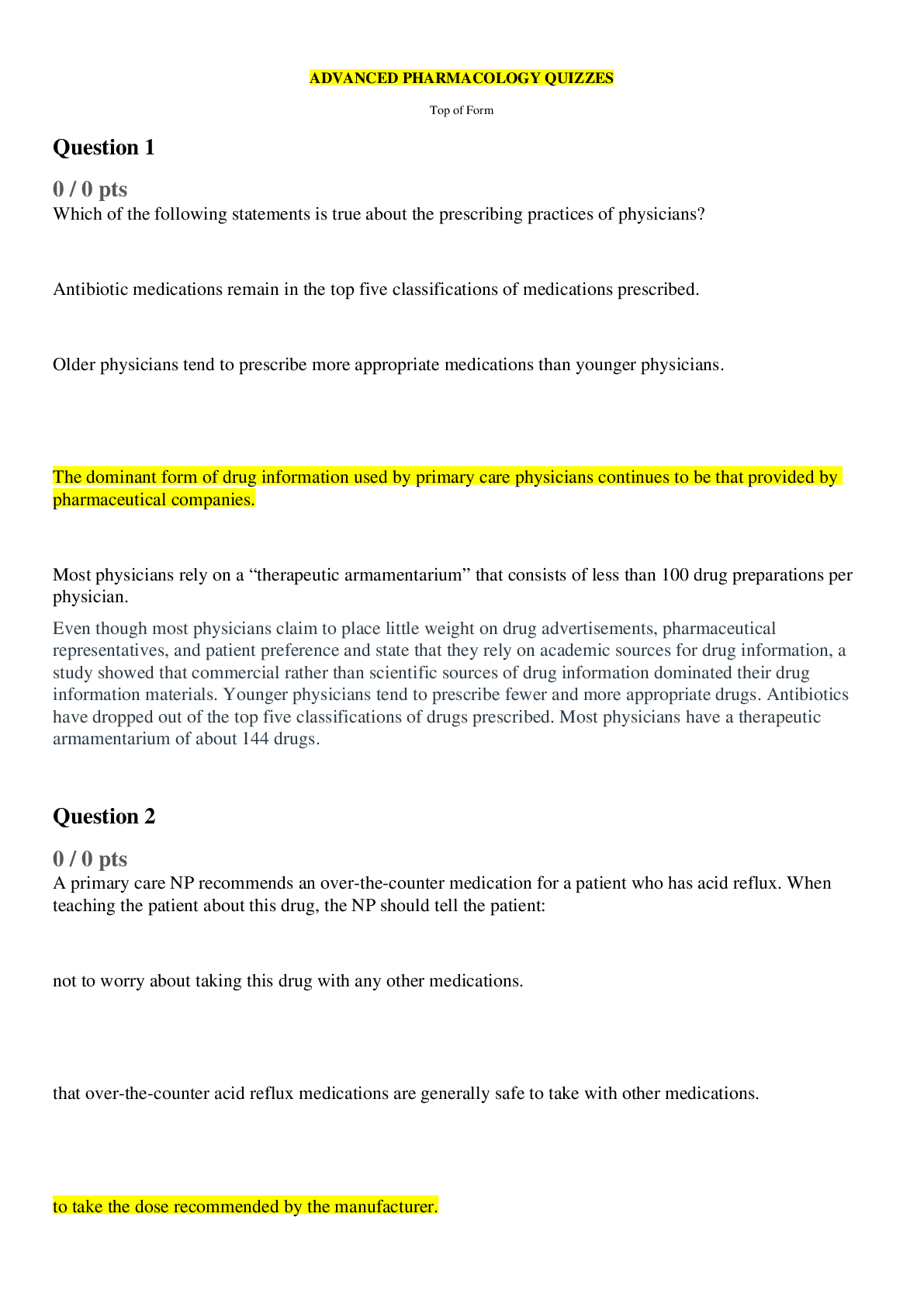

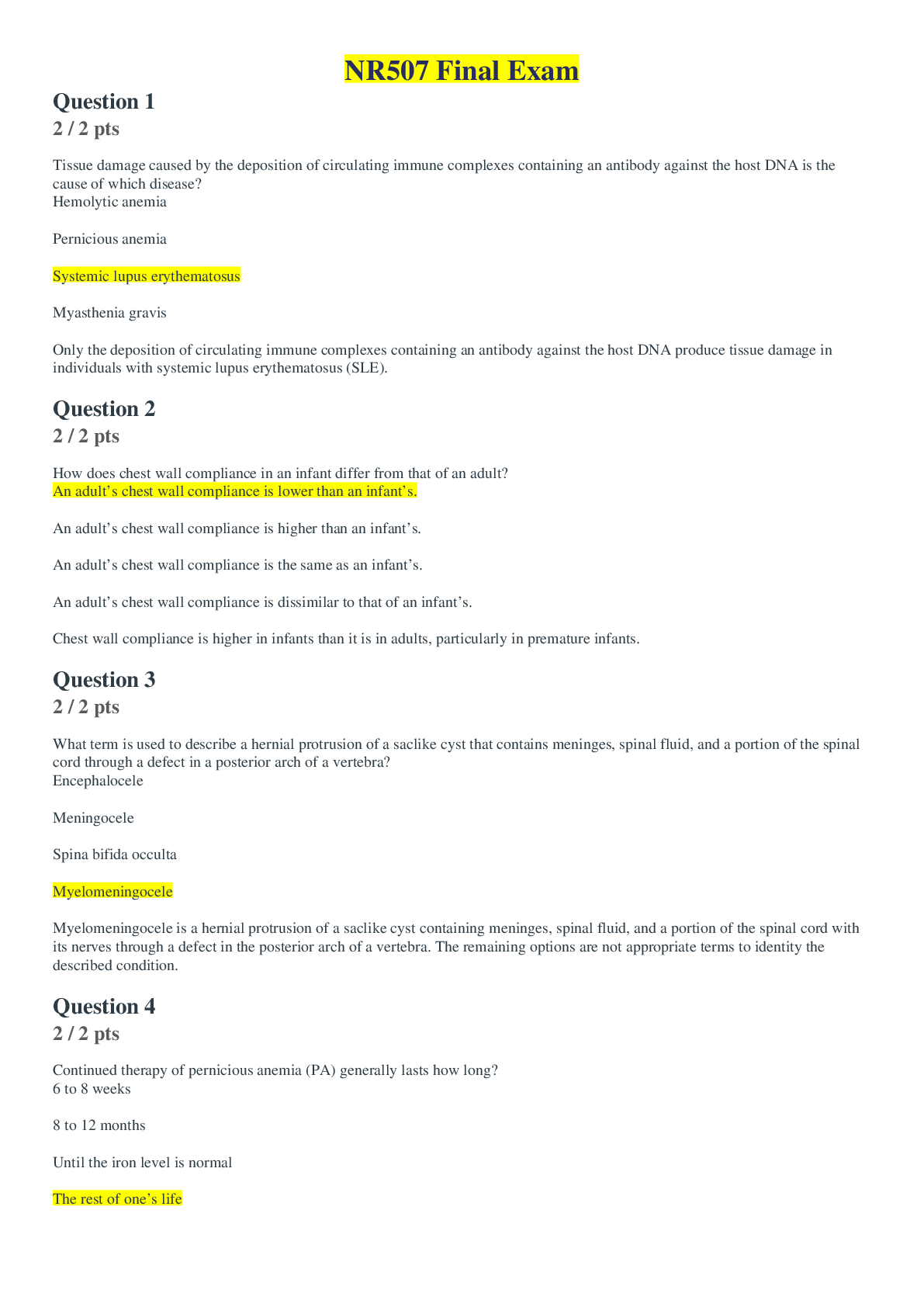

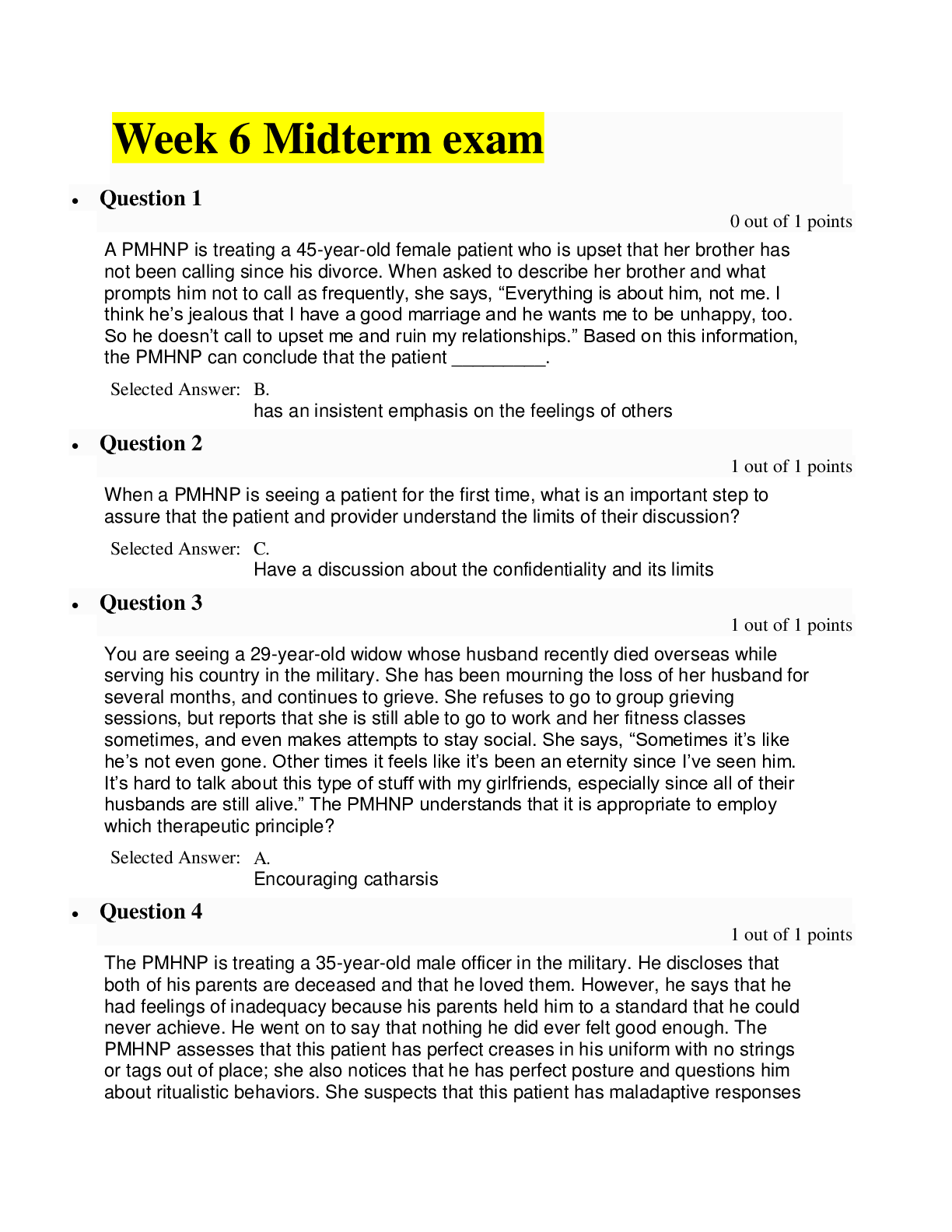
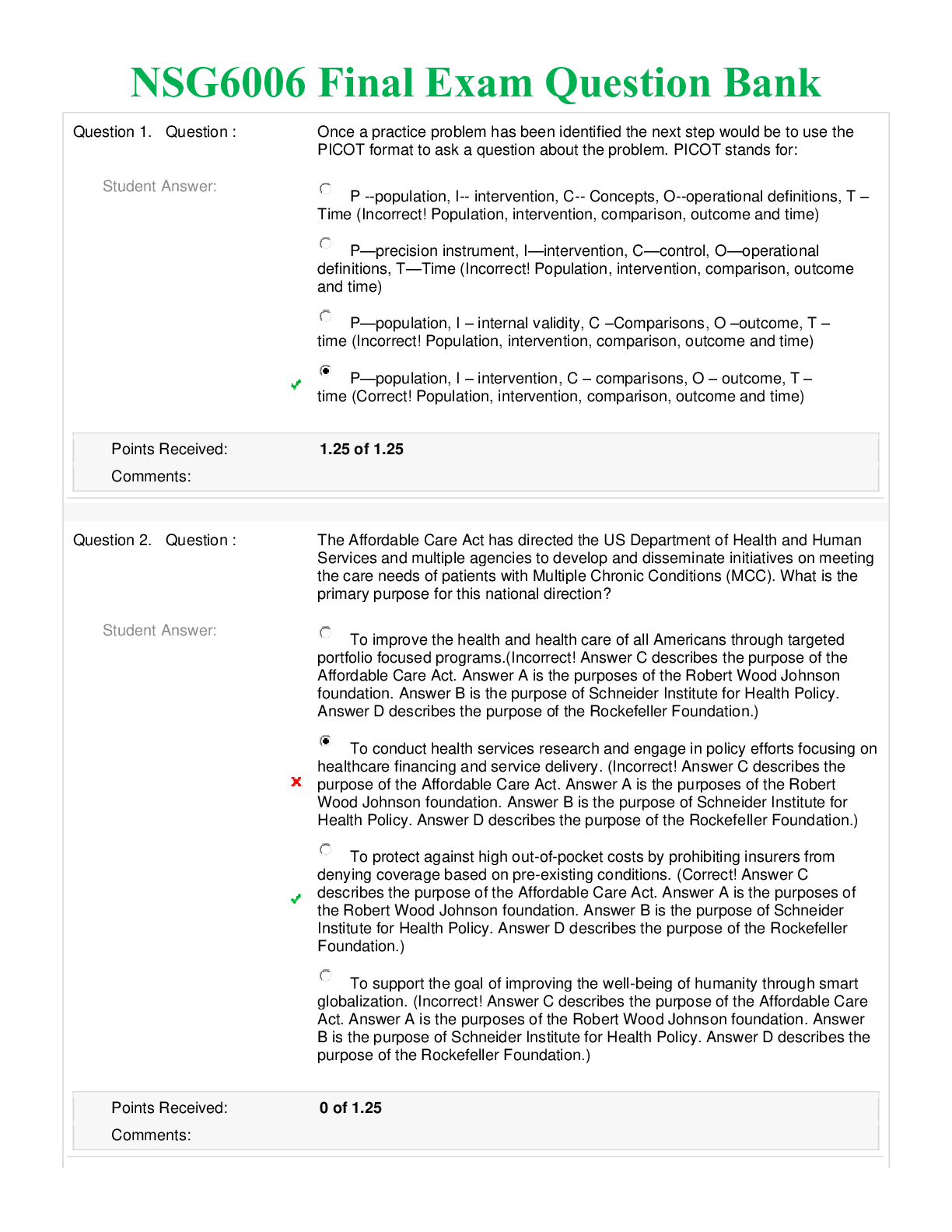



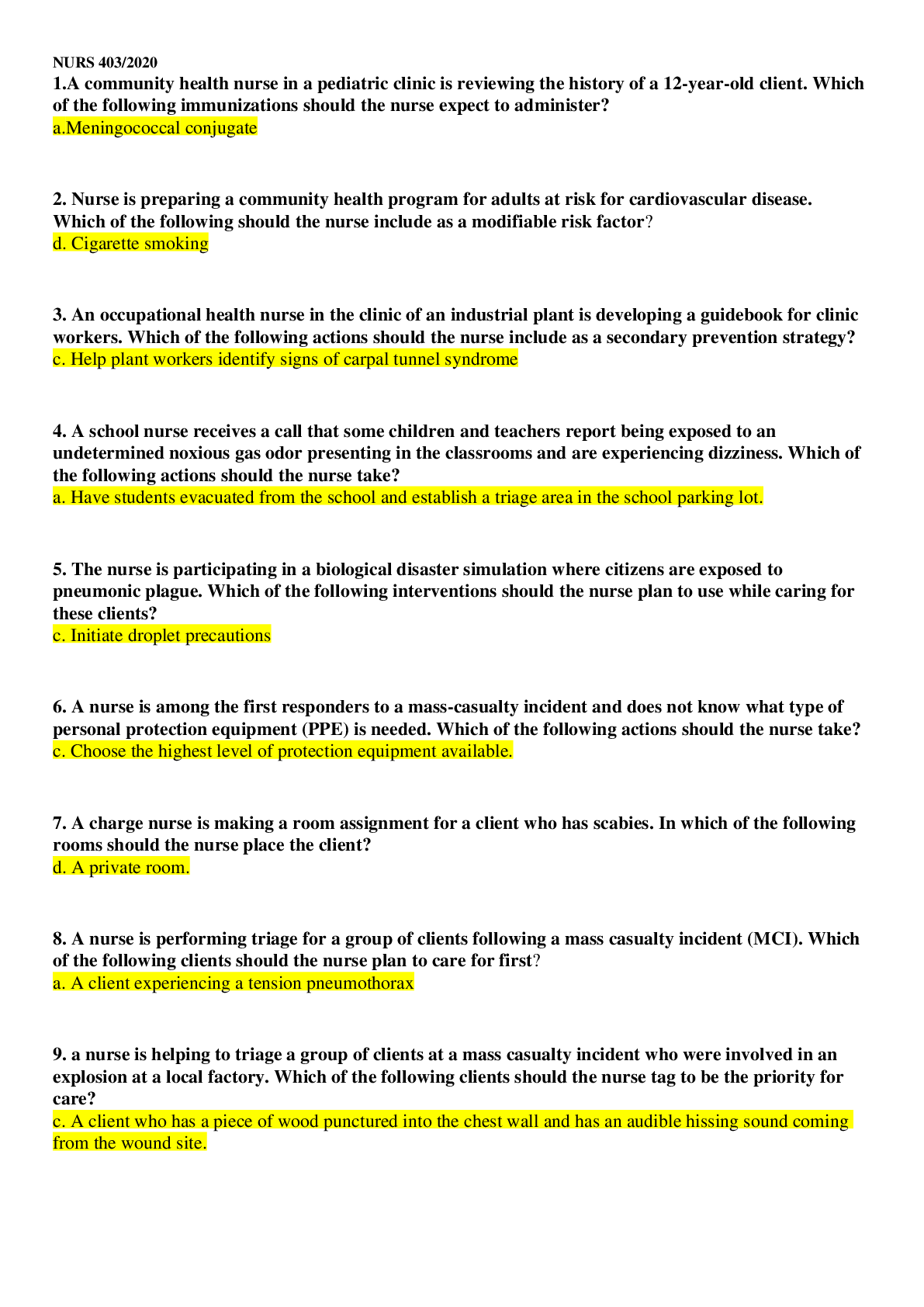
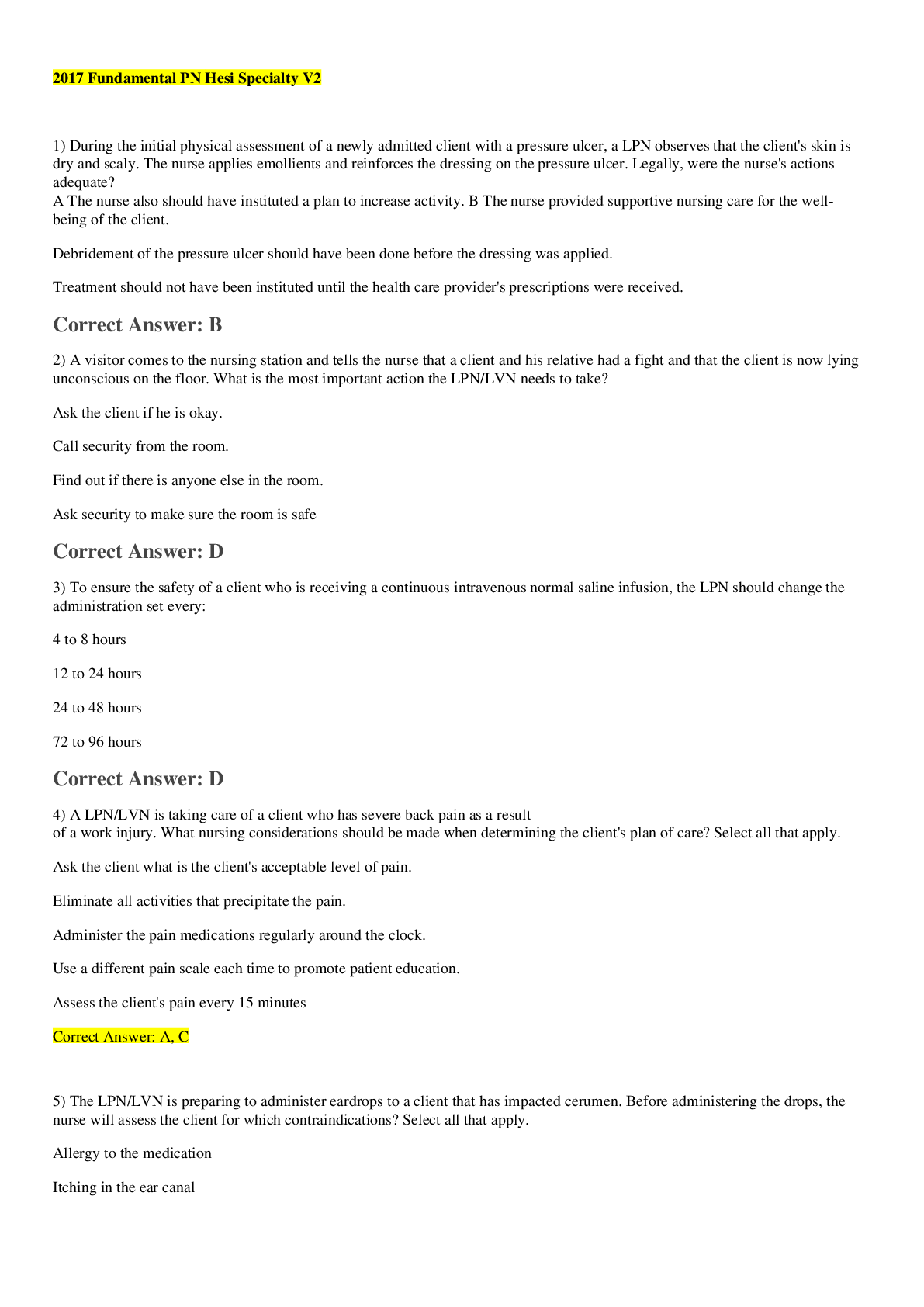


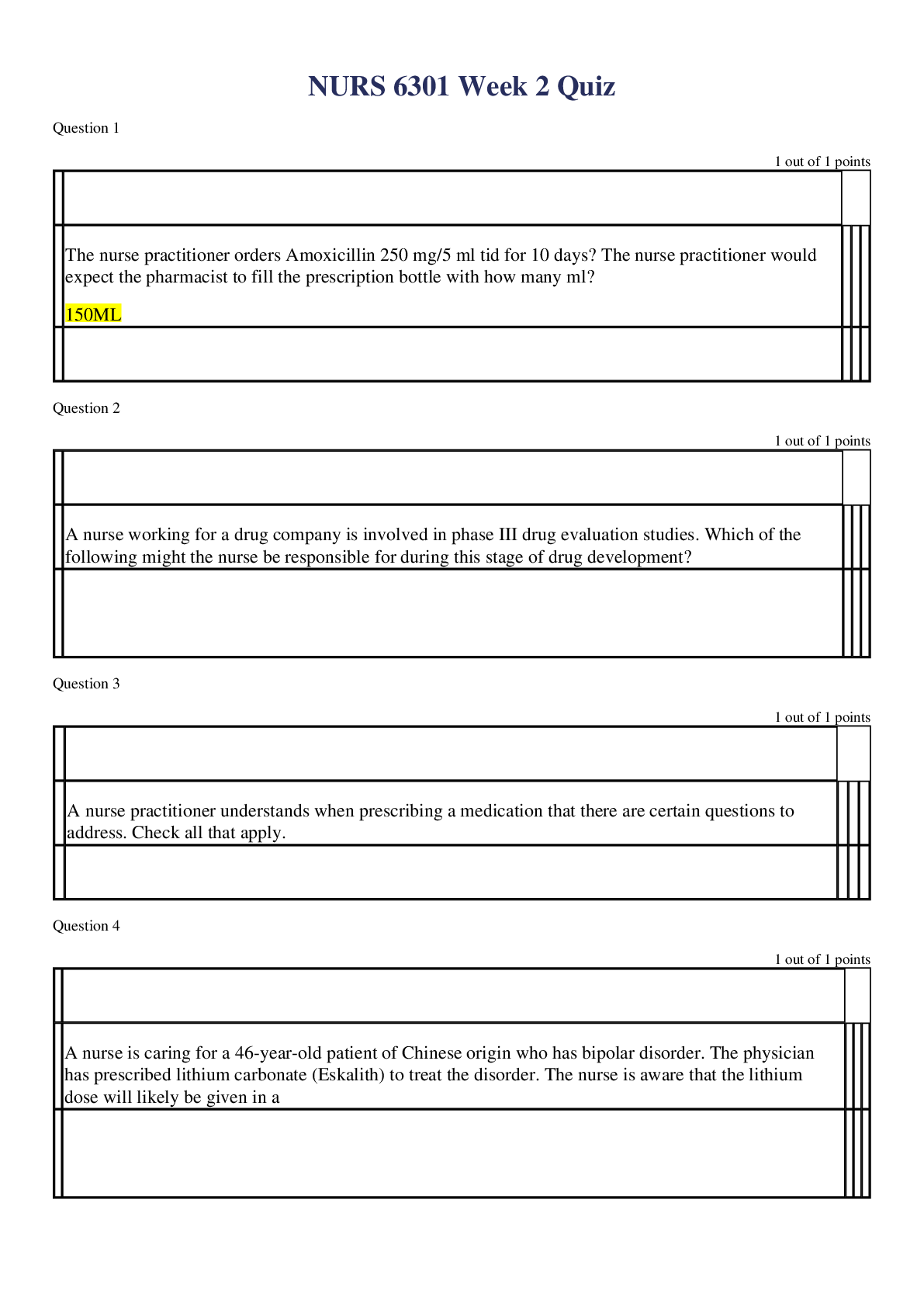



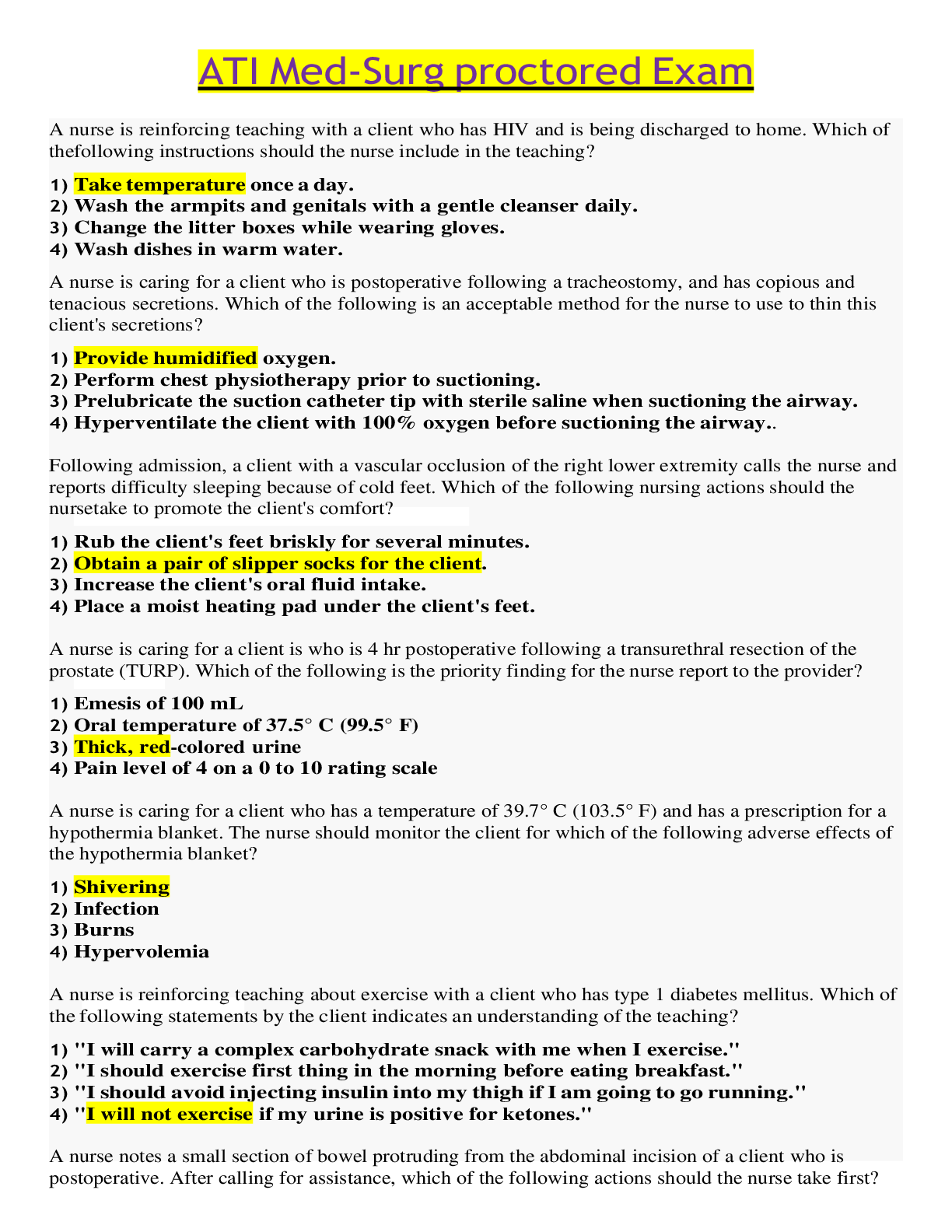


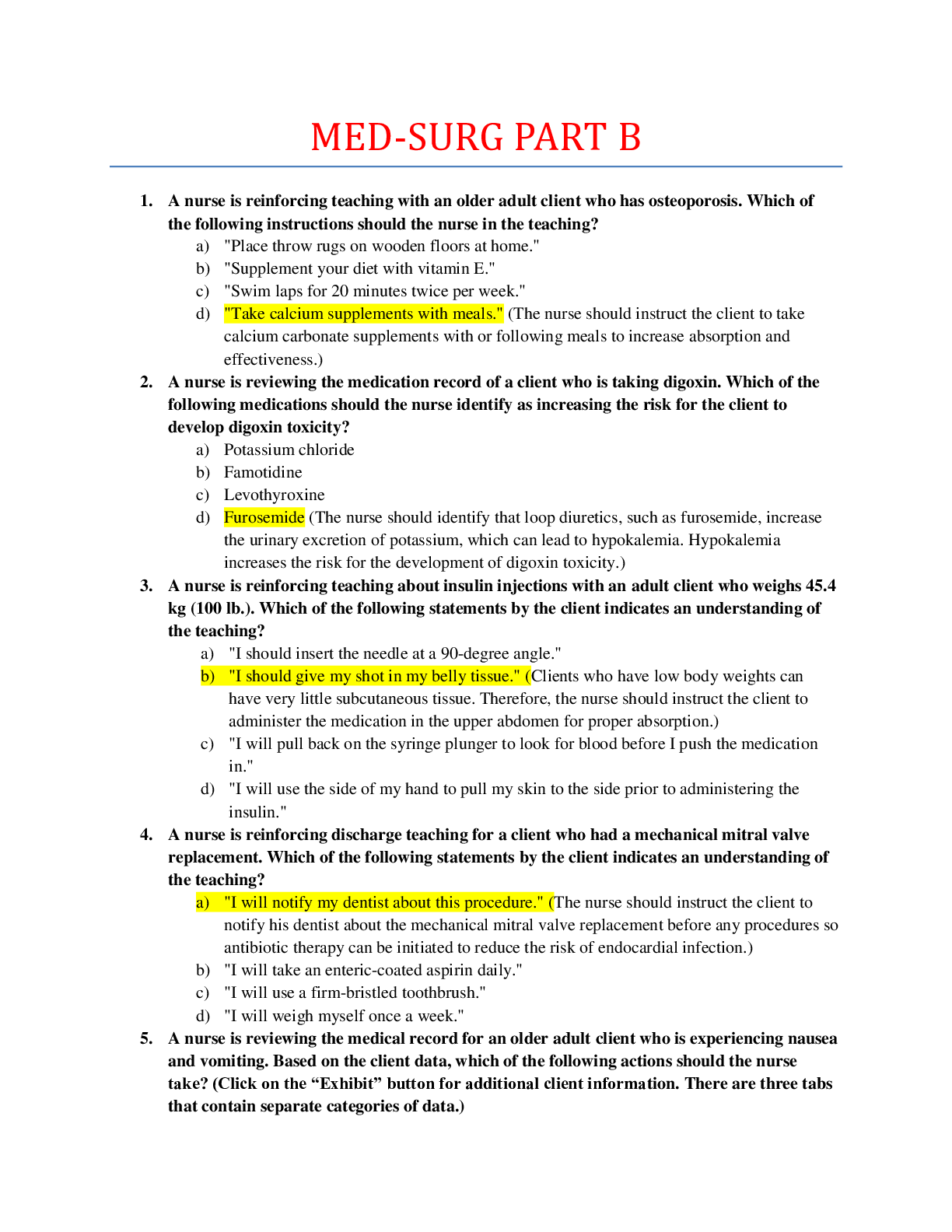
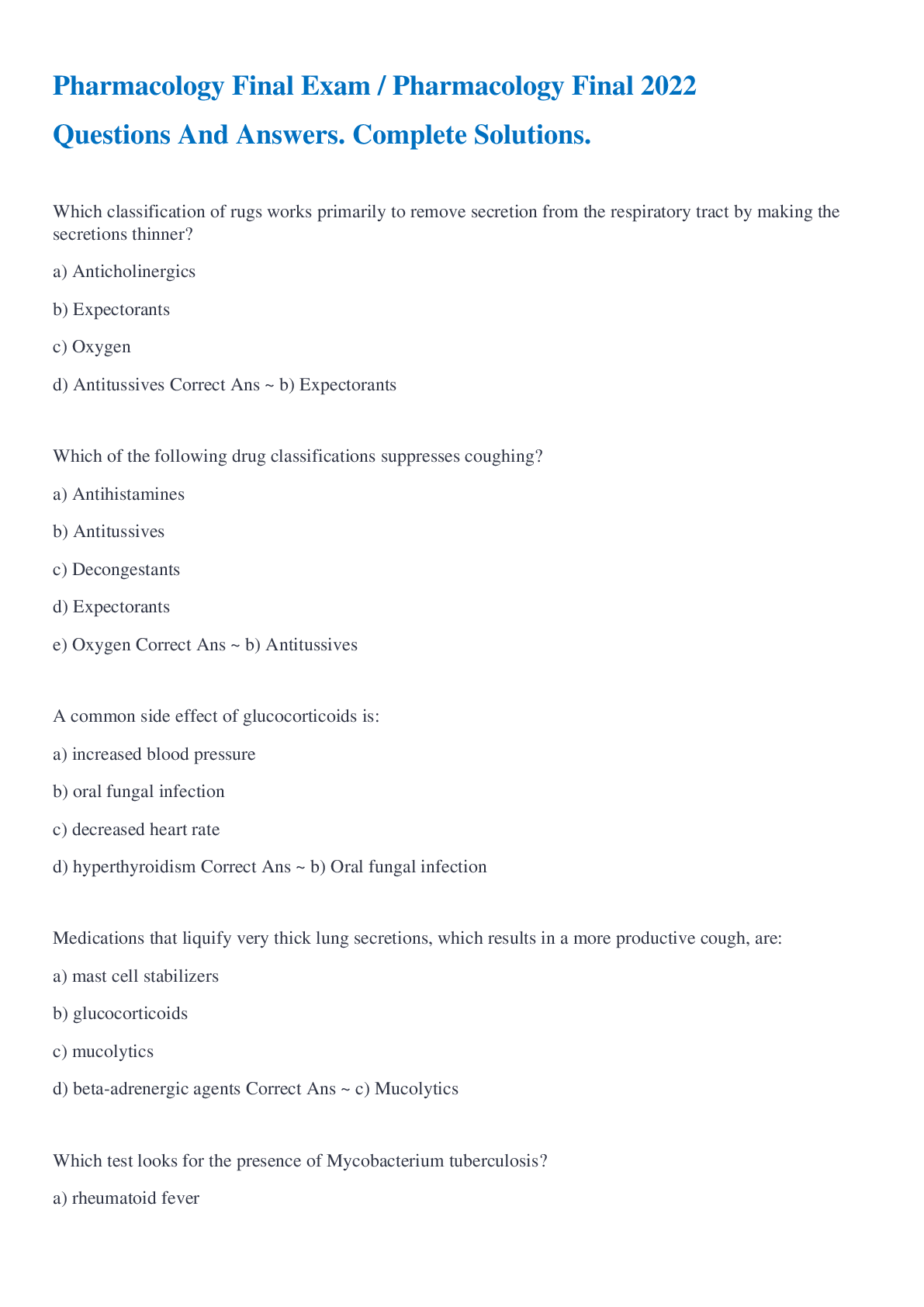
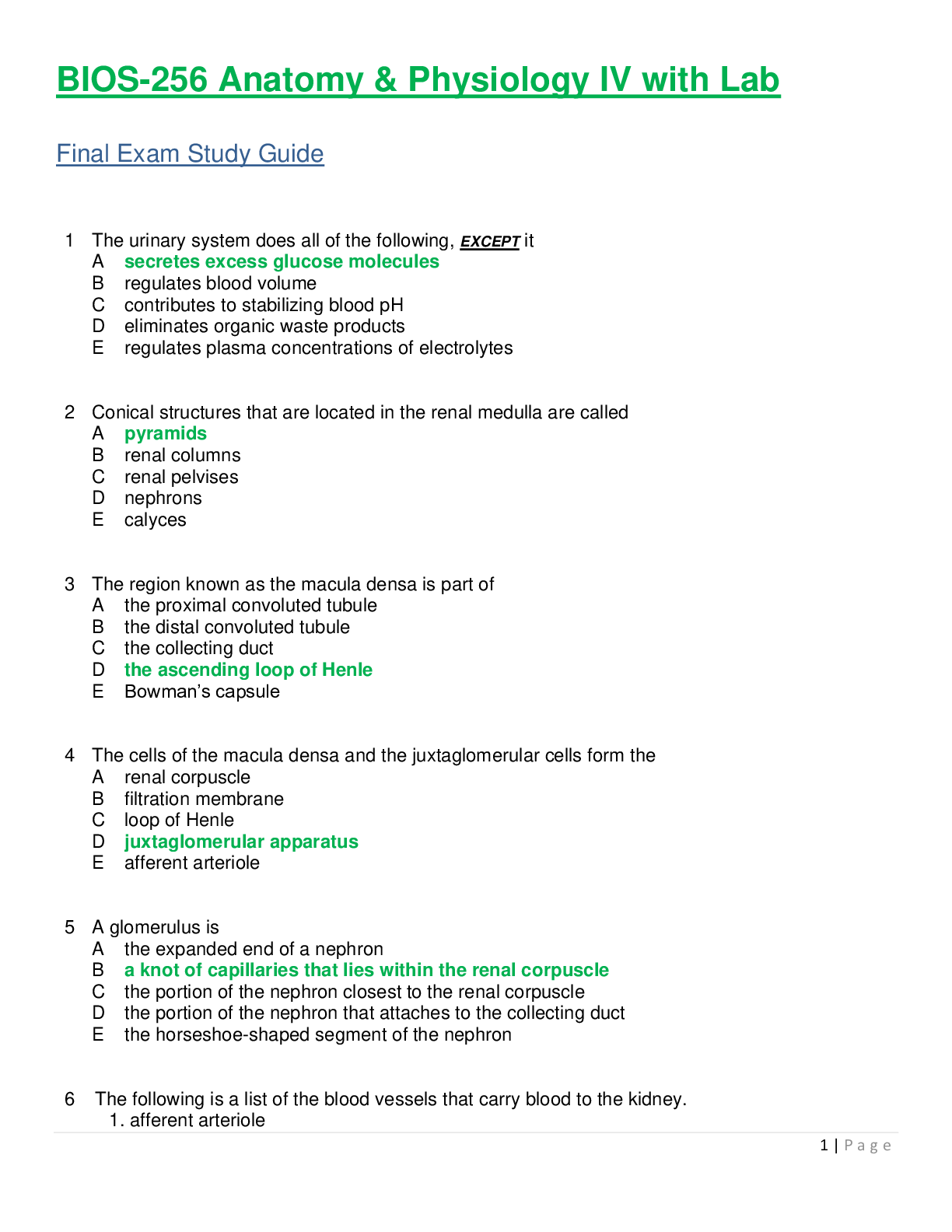
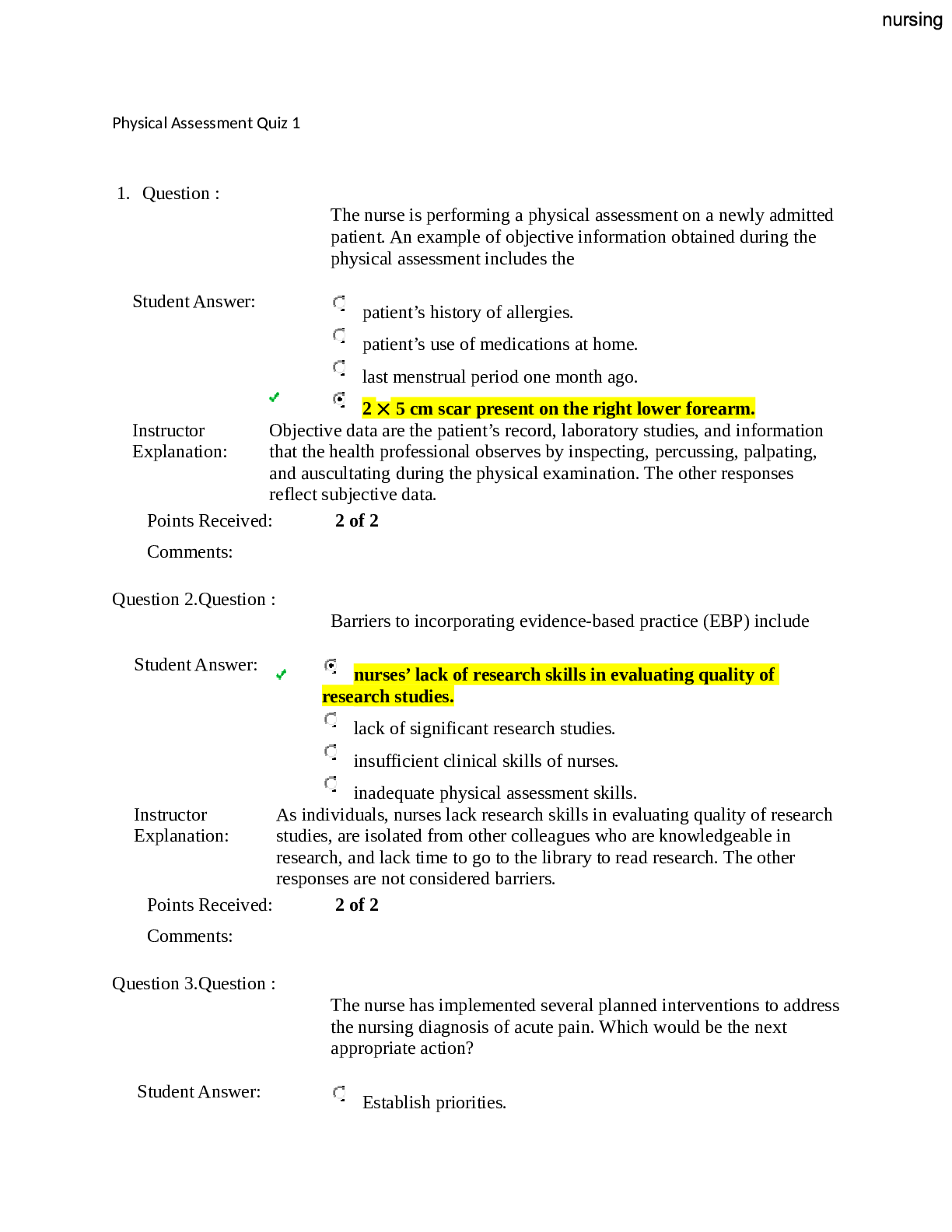


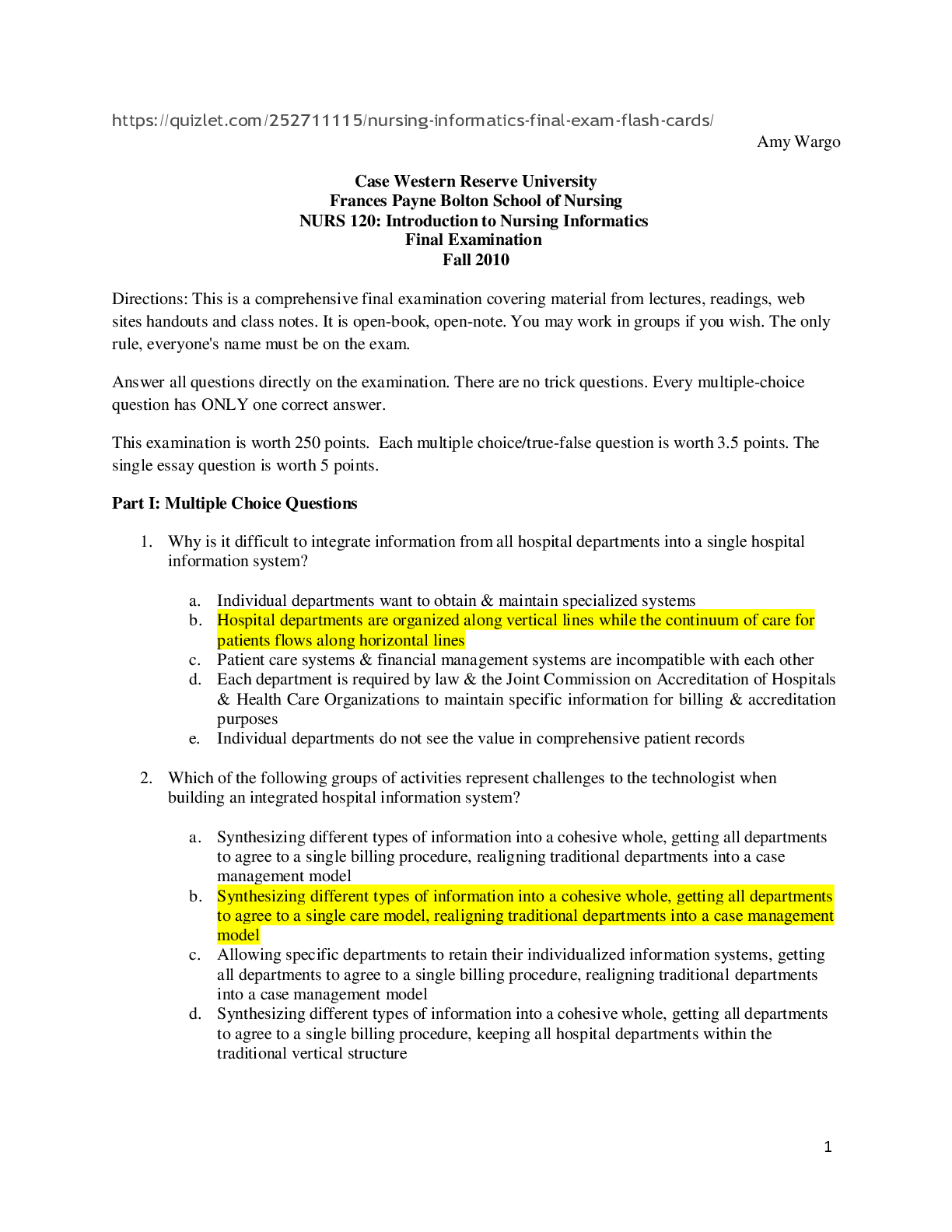
 – CHAMBERLAIN COLLEGE OF NURSING.png)

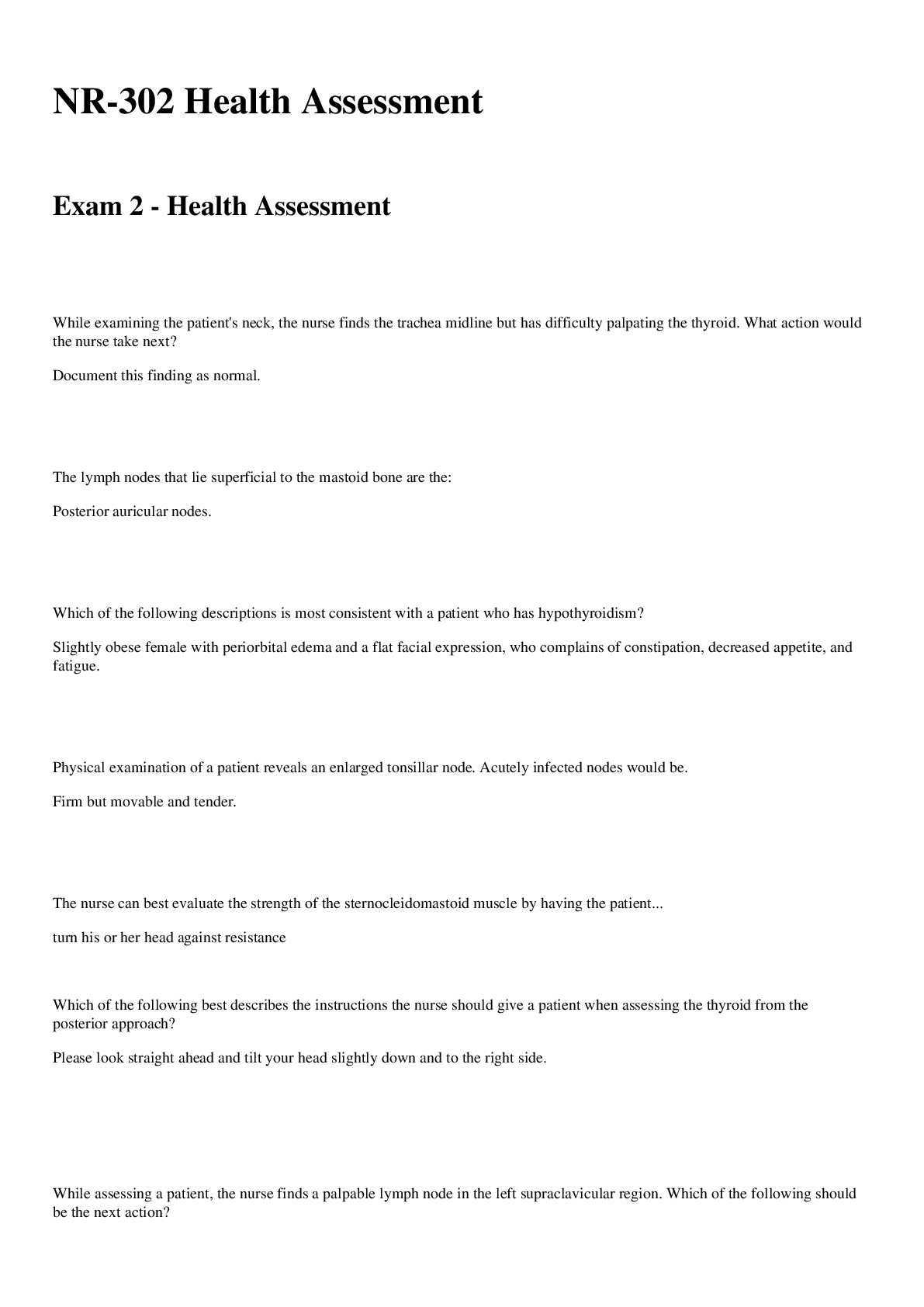

 – Chamberlain College of Nursing.png)




